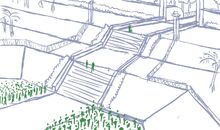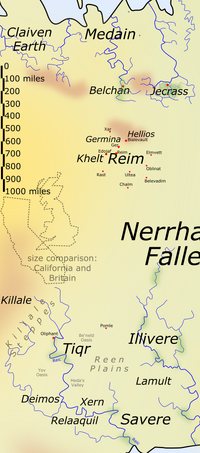
Khelt cityscape by Demonic Criminal

Detail Map of northeastern Chandrar (Artistic rendition), Khelt to the west of Reim
Khelt, also known as the Necrocracy of Khelt, is a kingdom of northwestern Chandrar. It's symbol is a skeletal hand holding a golden coin.[1]
Overview[]
Considered to be one of the few utopias in the world, Khelt is famous for its heavy use of Necromancy, relying on undead as for labor and military. Housing and food is free for the common citizen, and there are no laws requiring them to work.[2] The capital is Edojaf.
It lies to the west of Reim in a distance that can be covered easily in two days.[3] In its east, there is only the Zeikhal Desert and beyond that the Empire of Sands.[4]
Water is the most important resource of Khelt. It is either produced with Oasis Tears, delivered by magic such as hydromancy, or imported from other countries. The 'spent' water is stored for another use in large caverns.[5]
History[]
The nation of Khelt was founded by Khelta twenty-one thousand years ago.[6] She settled it bordering the Great Zeikhal Desert so that other nations would not covet the land.[7] As an extremely accomplished [Necromancer], Khelta created the pact that provides Khelt's undead legions and workforce.
The third [King] of Khelt was Thekheldan, in whose reign Khelt nearly fell from the apathy and excesses which were customary among the living citizens of Khelt. This necessitated reforms, which proved successful.
Khelt has suffered the attacks of Vampires when those ruled the world and briefly held Chandrar. Khelt fought back along with the Shield Kingdoms of the era and every other nation of Chandrar, and the continent was the first to drive out Vampires. This period in history may have happened during the reign of Khelt's fifth ruler, Serept, as he had forged weapons and armor to combat Vampires.[8]
Khelt's seventh ruler, King Dolenm, solved the nation's water problem and ended the risk of thirst. During that time period, Khelt pursued the arts, and Dolenm stole artworks from other nations so his citizens could copy them.
During the rule of its ninth ruler, His-Xe, and the reign of Queen Akhta, Khelt waged wars of expansion, annexing neighbouring nations and invading other continents. Annexed nations were offered anything they could want except freedom. The Isles of Minos [9]and the Circle of Thorns fought back against Khelt in those periods.
During the Creler Wars, Khelt use the Rites of the Revenant, opening three of its tombs to fight back against the Crelers. Other nations also let them create Razzimir's Arrows.
There have been periods where Khelt bowed to outside [Rulers] and lost its sovereignty, though they would eventually regain their independence. The latest of these took place recently when Flos Reimarch became the King of Destruction and Fetohep was forced to pay him tribute in food, coin and allowed a thousand citizens to join Flos' armies. Khelt became independent again when Flos's supreme reign over Chandrar ended.[5] Fetohep resolved to never allow Flos that influence again.
Chronology[]
Khelt sent armies into Reim after Flos awoke. The Quarass and Trey Atwood was sent to help negotiate an end to hostilities.[3]
The Blighted Kingdom's ritual on the Summer Solstice took three unborn children in Khelt.[10]
To fight back against the invasion of her nation, Queen Jecaina of Jecrass sold over a fourth of her lands to Khelt, including several rivers. Khelt declared war on Medain to secure its new territory and aid its ally, demanding the release of King Raelt.[11]
Fetohep personally went to defeat Medain, but was opposed by a knight crusade from Terandria, the Claiven Earth's army, and Medain's Named Adventurers. This would be the first time Khelt's ruler was seen slain in battle, though it was just a body double puppeteered by Fetohep.
Following the reveal that Fetohep was alive and well, he unleashed Khelt's greater armies. Khelt claimed two Named Aventurers and a Named-rank team. The Rites of the Revenant were used again, opening first three tombs, and later the remaining two.[12]
Following the Days of Return, three Gnoll tribes where offered citizenship and settled in Khelt. These are the Decles tribe, Satest Fletching tribe, and Gembow tribe.[13] However, Khelt also lost its vast army due to the souls disappearing, but must keep up the illusion of strength and prosperity lest it be attacked in its moment of weakness. The nation is subtly preparing for shortages and hard times.[13]
Layout[]
Cities:[]
- Edojaf - Capital City
- Koirezune - Also Capital City (?)
Areas:[]
- Forest of Nemask[2]
Government[]
Khelt has a monarchy government where the ruler becomes a Revenant [Undying King/Queen] in succession. It is traditional for rulers of Khelt to abandon their surnames as they serve their nations with no personal bias.[11] Ordinarily, the close companions of a ruler would also be turned into Revenants to keep them company through the centuries.[2]
Known By Order:[]
- Queen Khelta - 1st Ruler
- Queen Heris - 2nd Ruler
- King Thekheldan - 3rd Ruler
- King / Suzerain Serept - 5th Ruler
- King Dolenm - 7th Ruler
- Queen Emrist - 8th Ruler
- King His-Xe - 9th Ruler
- King Tkayl - 13th Ruler
- Queen Zushe-Greso - 14th Ruler (Ruled for 1,900 years)
- King Razzimir - 15th Ruler (Ruled during the Creler Wars era)
- Queen Akhta - 16th Ruler
- King Izimire - 17th Ruler
- Queen Xierca - 18th Ruler
- King Fetohep - 19th Ruler
Unknown Order:[]
- Queen ? - Garuda
- ?
- ?
- ?
- ?
Military[]
Former Strength[]
Khelt's ruler has absolute command over the undead workforce and armies. The armies consist of, according to several assessments, endless numbers of undead who can be raised from the ground at the will of the Khelt's ruler. The undead are so vast that 40,000 skeleton warriors are considered a message.[5]
Within Khelt’s land the Undead warriors are stronger, faster, deadlier, and imbued with the knowledge of combat. But elsewhere they become mindless and weaker, as Khelt's ruler’s power extended across their domain and weakened with every mile. Khelt's ruler could still send them to attack their enemies, but they would most probable get lost to the desert, turned into an undead horde that might well attack someone else or simply be lost. As such Khelt's ruler have to rely on politics and gold abroad, like [Assassins] to kill their enemies outside the kingdom. But within even the King of Destruction would beware invading Khelt.[2]
Only when Khelt's ruler personally leads the army out of its borders do the Undead warriors retain their strength and control.[11]
There are living people within Khelt's armies, referred to as Scourge Forerunners. They are citizens that have been granted the right to lead undead.[14]
Khelt has also retained much of its relics of the past, unlike many other nations. Armaments to slay Vampires, gemstone weapons forged by Serept,[8] and powerful potions and alchemical treasures stored within the Apothricarium.[2] Bone giants,[11] the corpses of Half-Giants, and the corpses of great beasts are among the greater undead it can bring to bear. Furthermore, Khelt's undead soldiers can be sacrificed to create other greater undead, such as Abominations of Bone.[14]
Some of the Revenant champions of previous rulers were entombed in order to aid Khelt in the future, should an emergency arise. Those revenants were the [Vizier] Hecreluum, the [Champion of War] Salui, the Honor Guard of Serept comprised of 20 Half-Giant warriors, 60 Scourgeriders with one unchained Djinni, and the Kheltian flagship Sand at Sea and its crew.
The mightiest undead Khelt could field aside from Revenants are undead Jaws of Zeikhal and the undead corpse of Zirconia the Ash Giantess.[15]A Jaw of Zeikhal can explode in a wave of death magic, and converts the area two thousand feet around it into deadlands.[14]One of the Jaws is equipped with a shrine of bone containing liquid essence of undeath, which changes the magical aura of surrounding undead, granting them [Invisibility] or [Speed] among other powers.[15] Khelt possessed seven Jaw of Zeikhal corpses, though previous rulers suggested they could've fielded at least eight, once.[12]
During the Creler Wars, Khelt developed a long range magical artillery weapon called Razzimir’s Arrows. It can launch a Tier 6 spell such as a giant [Arrow of Light] spell[15] and can strike other continents from Khelt.[16] Khelt has other spell scrolls with intercontinental range, including some that can summon living war monsters.[17]
The destruction of an army of Khelt's undead can be used to fuel the creation of a Graven Passage with their combined death magic. The Graven Passage looks like a great dais of bone, and is a portal that only the undead can use. It connects to another Graven Passage in Khelt, allowing them to instantly move their armies across great distances.[18]
Current Strength[]
Khelt has been severely weakened by recent events.
Because of the loss of the souls which animated the undead following the Days of Return, Khelt currently has no army. Only some undead that were animated by [Necromancers] are still active, and even then, their reactions are slower.[13] Khelt lost control of its four remaining Jaws of Zeikhal,[19] and the only remaining Revenants are the crew of Sand at Sea.
King Izimire had spent much of the Apothricarium's potions during his reign. Every intercontinental scrolls have been spent, effectively de-fanging Khelt overseas.[19]
Culture[]
All citizens are encouraged to pursue whatever passion and destiny they like, while food and shelter and many services are provided by the undead laborers. Among that is cooking, attending the king and occasional guests. Some even eschew classes to pursue various hobbies. One of the actually necessary jobs in Khelt is [Magistrate], in order to keep the peace and administer laws.[13]
The citizens of Khelt work for four days a week, and much less time than people of other nations. Physical work is not required. However, after their death, their bodies are reanimated to serve for menial labor. For that reason, there are no slaves in Khelt, the owning of which is illegal. After the Days of Return and the weakening of the undead force, citizens are encouraged to do menial labor as Commended Volunteers, with mixed results as some simply leave their task when they get tired of it.
They utilize a barter economy within Khelt, with the occasional fad currency.[20]
Citizenship[]
Citizens may leave Khelt if they wish, but this revokes their citizenship and birthrights. They may return to Khelt, but all immigrants (not only former emigrants) are required to bring something worthwhile into the Kingdom.[5]
Notable Citizens[]
- Adoive (Exiled)
- Alked Fellbow - Named adventurer
- Colovt - farmer
- Frieke - Named adventurer
- Pewerthe - potter, heir to the throne
- Teveti - [Magistrate]
Trivia[]
- Khelt is technically at war with about six Terandrian Kingdoms.[21]
- Currently there are 200 half-Elves living in Khelt.[2]
- There is a town in Khelt that allows nudity.[22]
References[]
- ↑ Chapter 9.68
- ↑ 2.0 2.1 2.2 2.3 2.4 2.5 The Revenant and the Naga
- ↑ 3.0 3.1 Chapter 6.54 K
- ↑ Chapter 6.14 K
- ↑ 5.0 5.1 5.2 5.3 Chapter 6.55 K
- ↑ Chapter 8.66
- ↑ Chapter 9.01
- ↑ 8.0 8.1 Chapter 7.46 K
- ↑ Chapter 8.49 M
- ↑ Chapter 9.46 S
- ↑ 11.0 11.1 11.2 11.3 Chapter 8.08 J
- ↑ 12.0 12.1 Chapter 8.32
- ↑ 13.0 13.1 13.2 13.3 Chapter 9.26 F
- ↑ 14.0 14.1 14.2 Chapter 8.26 FK
- ↑ 15.0 15.1 15.2 Chapter 8.78 F
- ↑ Chapter 9.23 GGGGGGGGG
- ↑ Chapter 9.66
- ↑ Chapter 8.84
- ↑ 19.0 19.1 Chapter 9.67 (Pt. 1)
- ↑ Interlude - Trade and Travel
- ↑ Interlude – The Innkeeper’s Knight
- ↑ Chapter 8.78
